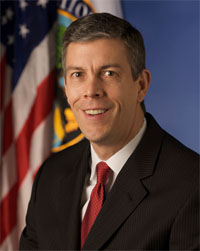Schools have right to form GSAs, reminds Department of Education

Arne Duncan
Schools receiving federal funds must provide equal access to school resources for all student groups, including gay-straight alliances (GSAs), said Secretary of Education Arne Duncan in a “Dear Colleague” letter to educators on June 14.
That has been true since the passage of the Equal Access Act in 1984, but Duncan’s letter was a reminder that many schools still unlawfully discriminate against GSAs.
The department’s general counsel, Charles Rose, issued a companion set of legal guidelines reiterating the key provisions of the Equal Access Act and schools’ obligations under the Act.
As Duncan explained in the letter, if a public high school allows at least one noncurricular student group to meet on school grounds during “noninstructional” time (lunch, after school, etc.), it may not prevent other noncurricular student groups from doing so, “regardless of the religious, political, philosophical, or other subject matters that the groups address.”
He noted that officials do not have to endorse any particular student organization, as long as they give all student groups the same opportunities to form, convene on school grounds, and have access to the same resources.
The Equal Access Act was originally promoted by conservative religious organizations wanting to protect student Bible study and prayer groups. It was signed into law by President Ronald Reagan and upheld by the U.S. Supreme Court in Westside School District v. Mergens in 1990, a case involving a Bible study group at a Nebraska high school.
More recently, however, it has helped LGBT students and allies in a number of cases in which they challenged schools over the right to form GSAs. At least ten such cases were brought between 1999 and 2010, according to Stuart Biegel, a member of the faculty at the UCLA School of Law and UCLA Graduate School of Education and Information Studies. And the LGBT students prevailed in just about every case, Biegel observed in his book, The Right to Be Out.
New cases keep coming, however. In mid May, students at West Bend High School in Milwaukee, Wisconsin, sued their school board in federal court, claiming it had illegally denied them the right to form a GSA.
In his letter, Duncan reiterated statistics from a study by the Gay, Lesbian, and Straight Education Network (GLSEN), which found that more than 90 percent of LGBT students in grades 6 through 12 reported being verbally harassed, and almost half reported being physically harassed, during the 2008-2009 school year. High levels of harassment, the study showed, “correlate with poorer educational outcomes, lower future aspirations, frequent school absenteeism, and lower grade-point averages.”
GSAs can help, wrote Duncan. In a press statement praising Duncan’s letter, GLSEN provided supporting evidence. According to GLSEN’s 2009 National School Climate Survey, LGBT students in schools with GSAs heard fewer homophobic remarks, were more likely to report that educators intervened when they heard such remarks, experienced less victimization related to their sexual orientation and gender expression and were less likely to feel unsafe. They also felt a greater sense of connectedness to their school community.
And in a separate study published in the May 2011 issue of Pediatrics, the official journal of the American Academy of Pediatrics, Dr. Mark Hatzenbuehler of the Columbia University Mailman School of Public Health found a positive social environment, including the presence of GSAs, led to a 20 percent reduction in the risk of attempting suicide for youth. There are over 4,000 GSAs in the country, according to GLSEN, and nearly 45 percent of LGBT students attend a school that has one. The first GSA was founded in 1988 at Concord Academy in Massachusetts, a collaboration between a straight student and gay teacher Kevin Jennings.
Jennings later became Assistant Deputy Secretary of the Office of Safe and Drug-Free Schools (OSDFS) at the Department of Education, a position he held until last week, when he left for the private sector. Among his other accomplishments, he organized the department’s first-ever LGBT youth conference, held June 6 and 7, at which the GSA letter and guidance was first announced.
The Department of Education’s announcement was not the only piece of federal support for GSAs in the past month. The Department of Adolescent and School Health at the Centers for Disease Control and Prevention, part of the U.S. Department of Health and Human Services, awarded the Gay-Straight Alliance Network over $285,000 on June 2 to help launch its new Safe & Healthy LGBT Youth Project, which will assist schools and community-based organizations in reaching LGBT youth. The Network is a national youth leadership organization that trains student leaders, supports student-led GSAs, and operates the National Association of GSA Networks, an organization of more than 30 statewide GSA networks.
And Jocelyn Samuels, senior counselor to the assistant attorney general for the Civil Rights Division of the U.S. Department of Justice, cited Hatzenbuehler’s findings in her testimony before the U.S. Commission on Civil Rights at a hearing to address bullying, harassment, and intra-student violence.
Duncan’s letter noted that the benefit of GSAs extends beyond LGBT students, those perceived as LGBT, and their family and friends. “By encouraging dialogue and providing supportive resources,” he wrote, “these groups can help make schools safe and affirming environments for everyone.”


Does this ability to create GSAs extend to students who attend Department of Defense Education Activity (DODEA) schools? Most of the students who attend those schools are military brats living on military installations overseas. If those schools receive federal funds–and I’m pretty sure they do–could DADT have been interpreted to also prevent GSAs on military bases? Thanks for your time, and I’m sorry if the question is confusing.